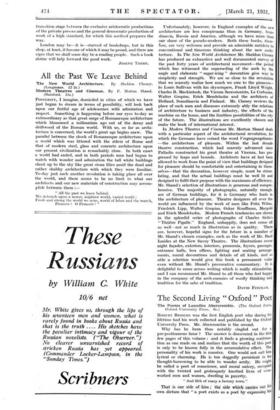All the - Past We Leave Behind
The New World Architecture. By Sheldon Cheney. (Longmans. £2 2s.) Modern Theatres and Cinemas. By P. Morton Shand. (Bataford. 15s.)
POSTERITY, I imagine, domiciled in cities of which we have
just begun to dream in terms of possibility, will look back upon our fretful age of adolescence ,with admiration and respect. Something is happening before our eyes to-day as
extraordinary as that great surge of Romanesque architecture which blossomed a millennium ago out of the decay and driftwood of the Roman world. With us, so far as archi- tecture is concerned, the world's great age begins anew. The parallel between the shock of Romanesque architecture upon a world which was littered with the debris of Rome and that of modern steel, glass and concrete architecture upon
our present civilization is remarkably close. In both cases a world had ended, and in both periods men had begun to
watch with wonder and admiration the tall white buildings shoot up to the sky like great stone lilies amid the dead and rather shabby architecture with which they were familiar. To-day just such another revolution is taking place all over the world, and there seems to be no limit to what our
architects and our new materials of construction may accom- plish between them :- " All the past we leave behind.
We debouch upon a newer, mightier world, varied world :
Fresh and strong the world we seize, world of labor and the march, Pioneers ! 0 Pioneers ! "
Unfortunately, however, in England examples of the new architecture are less conspicuous . than_ in Germany, Scan, dinavia, Russia and America, although we have more than our share of the pseudo-modern. Both these books, there- fore, are very welcome and provide an admirable antidote to conventional and timorous thinking about the new archi. tecture. In The New World Architecture Mr. Sheldon Cheney has produced an exhaustive and well documented survey of the past forty years of architectural movement—the period which has witnessed the superseding of the arch by the angle and elaborate " sugar-icing " decoration give way to simplicity; and strength. We are so close to the revolution that we' scarcely realize how much we owe to the pioneers— to Louis Sullivan with his skyscrapers, Frank Lloyd Wright, Charles R. Mackintosh, the Vienna Secessionists, Le Corbusier, Walter Gropius, Erich Mendelsohn and the architects of Holland, Scandinavia and Finland. Mr. Cheney reviews the place of such men and discusses extremely ably the relations of architecture to business and industry, the effects of the machine on the home, and the limitless possibilities of the city of the future. The illustrations are excellently chosen and make the book of international interest.
In Modern Theatres and Cinemas Mr. Morton Shand deals with a particular aspect of the architectural revolution, for which the Germans have coined the word Vergniigungsbavien —the architecture of pleasure. Within the last decade theatre construction, which had scarcely advanced since Palladio constructed his great theatre at Vicenza, has pro- gressed by leaps and bounds. Architects have at last been allowed to work from the point of view that buildings designed for pleasure should be comfortable and entertaining in them- selves—that the decoration, however simple, must be stimu- lating, and that the actual buildings must be well lit and designed to fulfil their purpose with the maximum of efficiency. Mr. Shand's selection of illustrations is generous and compre- hensive. The majority of photographs, naturally enough, are of German buildings, for it is Germany who leads in the architecture of pleasure. Theatre designers all over the world are influenced by the work of men like Fritz Wilms, Friedrich Lipp, Walter Gropius, Oskar Kouffman, Margold and Erich Mendelsohn. Modern French tendencies are shown in the splendid series of photographs of Charles Siclis's " Theatre Pigalle." England, unhappily, does not come off so well—not so much in illustration as in quality. There are, however, hopeful signs for the future in a number of Mr. Shand's chosen examples, such as the work of Mr. Basil Ionides at the New Savoy Theatre. The illustrations cover night facades, exteriors, interiors, proscenia, foyers, passages, entrance halls, box offices, lighting and seating arrange- ments, mural decorations and details of all kinds, and so able a selection would give this book a permanent value even without Mr. Shand's provocative commentary. It is delightful to come across writing which is really stimulating, and I can recommend Mr. Shand to all those who feel happy in the company of the arch-enemies of woolly thinking and tradition for the sake of tradition.
DAVID FLNCIIMI.


















































 Previous page
Previous page